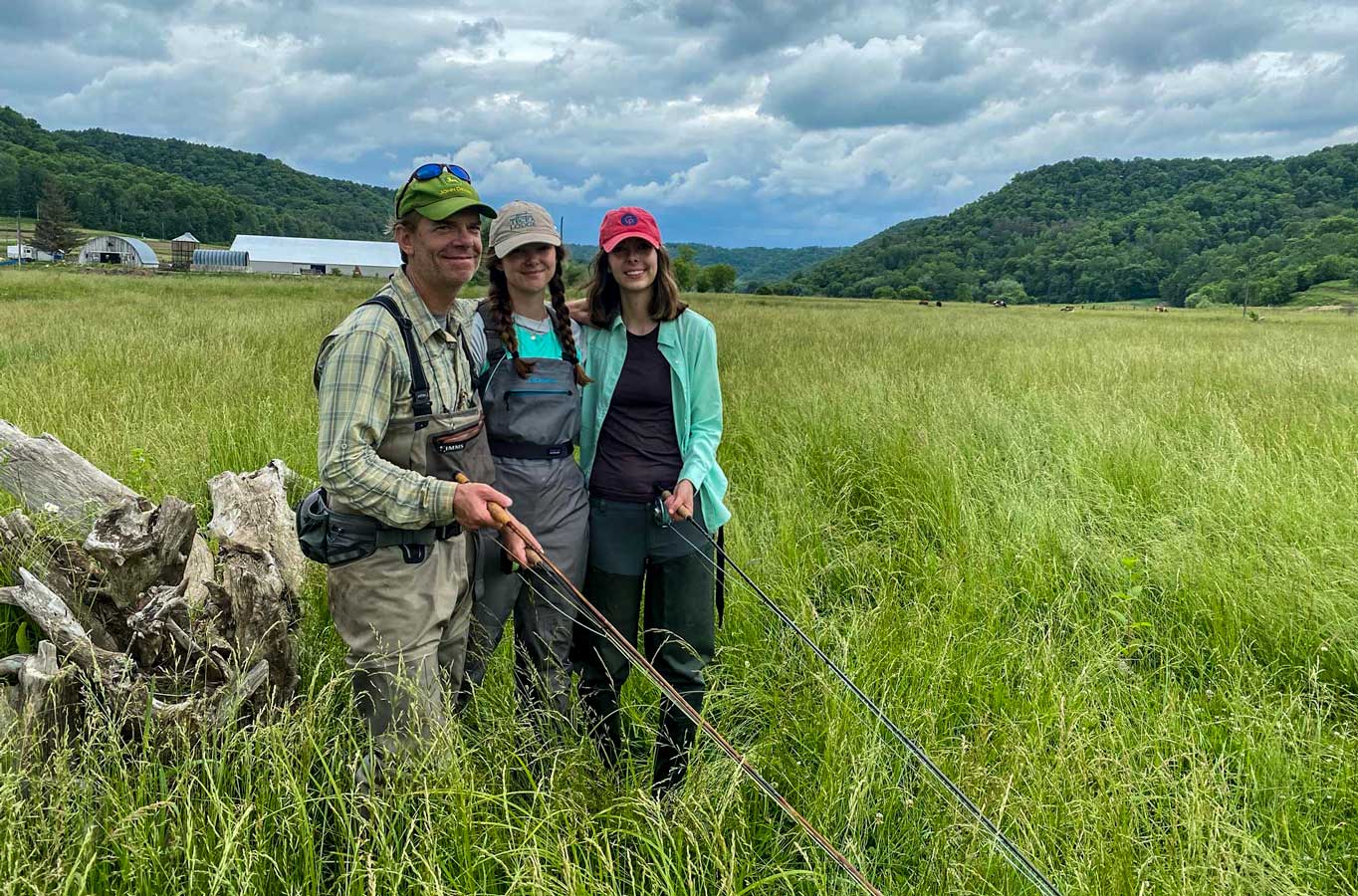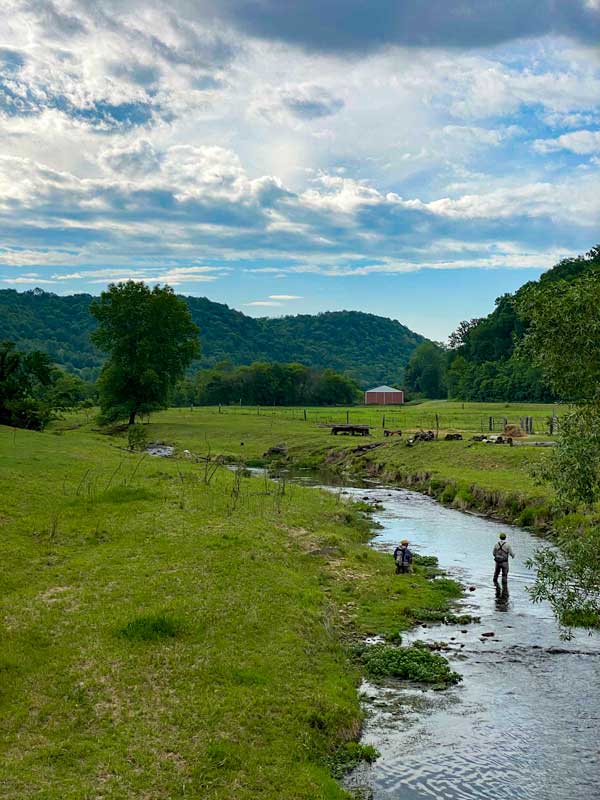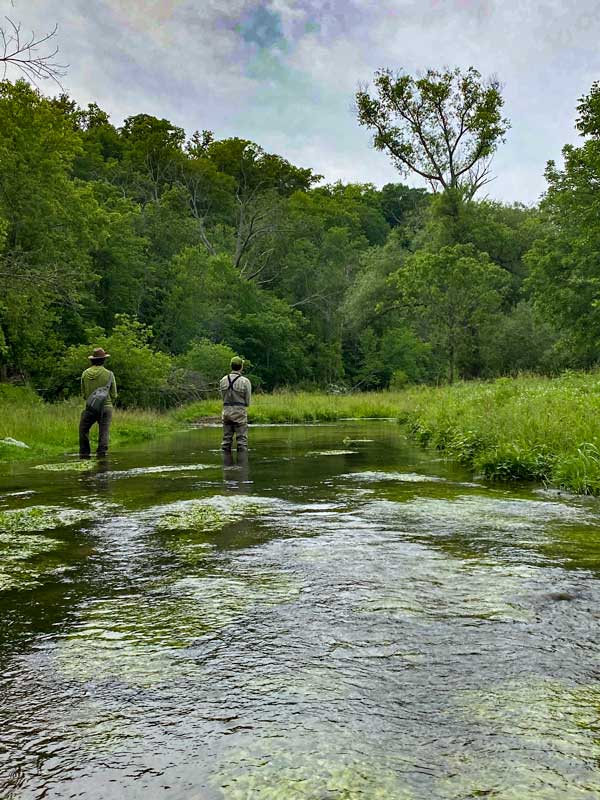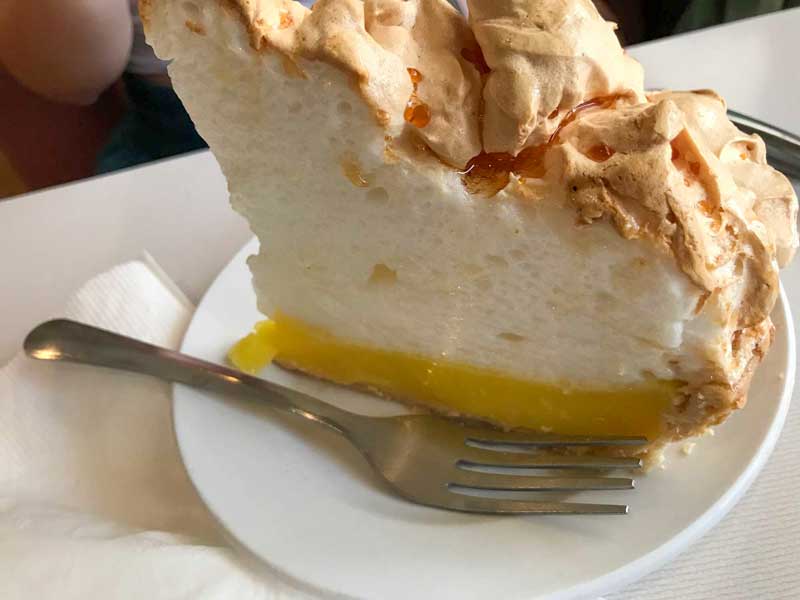Dry Flies, Foul-Mouthed Daughters and the World’s Best Cherry Pie: Fishing Wisconsin’s Driftless Area

Peter Cozad photo
On my third cast of the morning, I hear the tell-tale clunk of the fly hitting the rod. I figure no big deal. Just a quick untangle and we’re back in business. But oh what a tangle. No excuses either — there was no wind, and the creek runs through an open, grassy pasture. The banks are high but I’m fishing straight upstream. There’s nothing I was trying to avoid that might have made my cast wonky. Just a rushed back cast and an epic tangle.
If the tippet wasn’t so fine, or if I had actual glasses instead of cheaters, or if I had small nimble fingers instead of bratwurst, I might have a chance of getting it undone. Just when I start making some headway, the wind gusts, making the tangle worse and blowing away what little remains of my determination.
This was just supposed to be a quick run through of this hole. But I didn’t even get to the hole I was meant to fish because I thought: oh maybe I’ll check out that water down below.
Not that you shouldn’t try new water. But sometimes you get so distracted by shiny possibility you lose sight of the thing you were supposed to do in the first place. And while you’re off on that tangent, you get so tangled up you have to walk up to the car to get the gear you should have had with you. By the time you get back from the car, the fish have stopped rising. Opportunity has passed you by. Life lessons at eight am on a cloudless June morning beside a dainty, spring creek in the Driftless area of Wisconsin.
It’s a dry-dropper rig and just as I get it retied, Nick ambles down the creek.
“What the heck happened? I saw you go up to the car.”
Nick has sunburned skin, brilliantly blue eyes, wears a hoody and tan jeans and wading boots. He looks more like an aging skateboarder in a fedora than your stereotypical fishing guide.
I tell him my tale and he takes my line in hand and looks over my rerig job. Out come the nippers. As he’s retying, he tells me to work the deep pool up beyond the wire fence in front of me, then there’s a quiet run under a low-hanging tree. See if I can manage to get a drift below that tree.
He’s fishing with my daughter Wynn in a hole just up from there and they’re hauling them in. So unless something changes, I’ll find him there. Last night Wynn didn’t catch a lot of fish and bravely said it’s not about the body count. Good form and absolutely true. But, Nick says, “it’s a heck of a lot more fun catching fish.”
He looks down at the rerigged flies, says, ok you’re good to go and disappears in the tall grass. I make several casts up the pool, finally reaching the chute where the feeding fish should be. There’s no doubt there are fish in here – they were surface feeding earlier and the fish numbers in the Driftless are staggering. But they’re not feeding now, above or below. So I reel in.

Zara Johnson photo
Walking the bank I can see way up the valley. The creek winds through a vast grassy meadow up past an immaculate farmstead: tidy white-frame farmhouse, classic red barn and silo. A herd of Angus grazes where Wynn and Nick are fishing. Big boulders are stacked all along the creek – they’re there for an upcoming stream restoration project but they look Neolithic, like druid monuments dropped down in the middle of Wisconsin. The flat valley bottom rises suddenly on either side to steep wooded hillsides. It’s a peculiarity of the Driftless that these hillsides are in reality not hills at all but the sides of ancient eroded canyons. There’s flat farm ground on top. That’s why the main creek in this watershed is called Timber Coulee. Because this isn’t a valley between hills, but a soft-focus canyon below a plateau.
I climb the stile and on the other side, in that deep pool, I start catching small browns and the occasional brookie, all on the dropper. When things slow down, I go upstream to the hole with the overhanging tree. Many flailing, hap-hazard casts later, I manage a nice drift in the bubbles below the tree branches. Nothing. No surprise there: the whole run was probably blown after my first couple of casts.
Upstream past a glowering momma cow, Wynn’s still catching fish. As Nick joins me on shore to show me some water upstream, Wynn lands another fish and deftly releases it. It’s one of those moments when it hits you hard how fast your kids are growing up. It seems just the other day
I’d stand behind her and help her cast, my hand enveloping both her wrist and the rod handle. Now, at sixteen, she’s nearly as tall as I am. And if she’s still got some things to learn about fishing (don’t we all?), she’s ten times the angler I was at her age.
Nick leads me up to the next pool and spends a few minutes with me. Nothing’s biting so he motions me over, ties the dropper on a foot longer tippet. I catch three respectable browns with the next three casts. “Ok,” he says, “I think you’re good,” and goes back down to fish with Wynn. I land a few more fish from that pool and then amble upstream among the Neolithic boulders. I cast a few times into some narrow, fast water but don’t catch anything. The sun’s getting high, the day’s getting hot, the fishing’s slowing down.
Back at the cars, Nick asks if we don’t mind finding our own way back to town. He needs to head in the other direction because he has an appointment to pick up a rooster. For no good reason, the idea of Nick having an appointment to pick up a rooster strikes me as hilarious. I start laughing my ass off and Wynn and Nick look at me like I’ve lost my mind. “It’s really easy,” Nick says a bit tentatively, caught off guard by my laughing, “it’s just your first left and that takes you right back to the highway.”
And it is easy. As we drive out of the coulee, I remind Wynn about Borgen’s diner in Westby. We ate there a couple of years ago. Cherry pie to die for. “Sounds good.” Wynn makes the call and we meet her sister Zara and my wife Christy a few minutes later. Spoiler alert: the cherry is just as good as I remembered, but if you ask the girls, the lemon meringue stole the show.
***
That evening, Zara and I are following Nick’s car down a winding road in a steeply wooded, narrow hollow. Where the bottomlands of the Driftless are endless grassy fields surrounding expansive farmsteads, reaching up to wooded hillsides, the headwater valleys are narrow, steeply-sided and shadowed. The road follows the path of the creek. The houses, what few there are, perch in small yards seemingly hollowed out of the hillside. There’s a palpable sense of isolation and innocence in the landscape. Rabbits in the road look up at you like they’ve never seen a car before and saunter out of the way as you approach. Deer in their orange summer coats cock their heads and look at you, then trot off, stop, and look back again. A skunk ambles down the middle of the road like he knows he’s got right-of-way. (He does.)
The valley and the twisting, curving, narrow black-top remind you more of the Ozarks or Appalachians than Wisconsin dairy country. But the fact that this back road is actually paved means we could only be in Wisconsin – because of the weight of dairy trucks, rural roads that would be gravel anywhere else are paved in Wisconsin. Nick stops on a bridge, rolls his window down to look up and down the creek and the road, and then turns around. There’s no shoulder so to turn around it’s a three point turn twice over. That’s a six point turn, right? We follow him back down the road a quarter mile or so and park.

Zara Johnson photo
The creek bottom glows green in the yellow evening light, sparsely wooded and grazed-down but, like most of the land we see in the Driftless, not over-grazed. We wader up, grab the rods, follow Nick along a fence line down a gentle slope and slide into the creek.
The fence goes across the creek; upstream is private property. “It’s technically illegal to fence across the creek like that,” Nick says, “but everybody does it. Because otherwise how’re you gonna keep your cows in?”
For obvious reasons, Nick knows a lot about Wisconsin water laws. It’s one of the few states where both the creek bottom and the water in the creek are state owned. According to Nick, it’s the only state where this ownership is enshrined in the state constitution. The upshot for anglers is that if you can get into a waterway from a public access, you can fish all that water so long as you stay in the water. These laws are why this area has something like a hundred miles of publicly-accessible trout fishing. And that embarrassment of riches is likely why, in three days of fishing during the June high season, we won’t see a single other angler.
We duck under the fence and Zara leads off. She’s casting well, straight upstream to the top of the smooth, narrow current that turns out of a riffle above. It takes her a couple of casts to hit it just right but when she does a trout takes her dropper. “Set! Set! Set!” Nick implores but by that time the fish is gone.
Zara’s eighteen, not quite six feet tall, with pig-tail braids, a baseball cap and a mouth to make a sailor blush. She says a word that rhymes with “duck” rapid-fire six times. Nick laughs. “You gotta watch that dry.”
I say, “You kiss your mother with that mouth?”
“Duck off, Dad.” Ah, fatherhood.
The next time she sets the hook so hard that the small, startled trout gets thrown back to the fence line behind us. Finally, she finds her rhythm and lands a few fish. I take my turn and land a couple and we decide to move up.
The creek widens into a weedy flat then turns right and straightens up against the far side of the valley. The sun’s dropped behind that hillside so we’re fishing in the shadows now, the pale cropped grasses and evenly spaced trees giving it a park-like feel. Zara and I trade off fishing through a couple more holes. We keep catching fish on the dropper, but there’s nothing happening on the surface. Nick says there’s a place downstream where the fish might be rising.
We drive down to a wide spot in the road called Cooperage, Wisconsin. The barrel factory that gave this place its name is long gone. There are two-boarded up stores from the early nineteen hundreds and a couple of houses that have seen better days. We pull off the road a bit beyond, where a side road leads to a bridge across the creek.
When I get out of the car, Nick looks up from his phone. “Sorry, I just got reception back and that rooster just hasn’t figured out his place. He’s causing so many problems.” Several smart-ass comments about pecking order and, well, peckers come to mind, but I keep them to myself. This is serious business for Nick.
The landscape has opened up from the close confines of the creek’s headwaters. On the other side of the bridge is an old farmstead that Nick says is the front part of a five-thousand acre parcel a lawyer recently bought for several million dollars. On one side of the barn there are six or seven deluxe deer blinds they’re getting ready to put out. “Yeah,” Nick says, “he kind of figures this is his little creek right here but that’s not how it works.” I know Nick knows his water law, but I can’t help worrying about shots across our bow from an over-entitled land-owner testing-driving one of his deluxe deer blinds.

Willoughby Johnson photo
Above the bridge, fish are rising along a bubble line on the right bank. There’s about an hour of daylight left so the fly is hard to see and Zara’s tired. Nick reminds her to strip in line and she harrumphs in frustration not at Nick but at herself. Her casting is desultory and lazy and Nick has to untangle her a couple of times.
When her back cast reaches four o’clock I say, “Hey, not to be the guide but your back cast is going back pretty far.” I’m ready for a torrent of invective but Zara’s so tired that she just says, “Ok, thanks.” Nick and I both look at each other in surprise. It’s only been two days but he already knows Zara well.
I take my turn and don’t have any luck, so we move up to the next pool. Zara lands a fish or two and gives me the rod. After a few casts, there’s a stirring beside me and a chocolate lab puppy stares up at me from the water.
Nick: “Baby otter!”
The otter porpoises a couple times in front of me before disappearing downstream. “That’s why we haven’t been catching much,” Nick says. “I probably won’t come back here this summer. But in two years, man, the fish will be big.”
For a long time I had the old-school angler’s dislike of predators – herons, otters, mergansers. Even eagles. Only recently have I gotten it through my head what Nick just implied – there’s a balance to be struck between predators and prey. And in the case of trout, the result of that balance is fewer, but bigger and stronger, fish. One of the great things about the Driftless is also, arguably, one of its flaws: these creeks are absolutely packed with fish – as many as twenty-five hundred per mile in often skinny water. And there are big fish in them – but if there were fewer fish there’d be more big fish.
Somehow the sight of the otter has made us all wordlessly agree that our day is done. Back down the creek, trout are rising to the bubble line where we started. But it’s nearly dark and we’re all beat. Zara and I head back to meet Wynn and Christy for dinner. Nick heads home to calm his seething chicken coop.
***
Next morning and we’re fishing with Peter. Last night as we took off our waders, Nick said, “Peter guides really different from me. He’s a good guide, just different.” When we meet Peter in front of the fly-shop, one of the first things he says is, “Nick’s a great guide but I’m a little different. Not right or wrong, but different.” It was nice of them to tell us this, but we probably could have figured it out for ourselves: Peter’s coiled intensity couldn’t be more different from Nick’s relaxed vibe. Nick looks like he slept on someone’s couch last night. Buzz-cut in head-to-toe camo, Peter looks like he just got back from a tour of duty with the fly-fishing Marine Corps.
Up to now the girls had been alternating morning and evening fishing with me, but this morning they’re both along. We follow Peter north towards Timber Coulee. We park beside a bridge by a trickling feeder creek. Peter and the girls will fish downstream where the water widens out – I’ll fish just up from the bridge.
It’s overcast but with no wind it’s steamy and stifling. Peter tells the girls to sit tight and leads me through an open gate, past a fence-post auger haphazardly laying in the grass, down to the little creek. There’s a short section of fast, smooth water, then a riffle above it and, above that, a long glassy pool below a small waterfall. Even from where we are we can see that fish are consistently rising.
“Ok,” Peter says, “they’re feeding right below the surface, some kind of emerger.” He opens his fly box and scans the contents intently, plucks out a couple flies and snaps the box shut. “So I’m gonna put this on and then if they don’t take that you’ll have this Parachute Adams you can try.
You’ll just fish the far bank all the way up, first this bubble line in this fast water and then the same side up there. Take you forty minutes. Sound good?”
Yep. And as it turns out, Peter is right about everything except the forty minutes. This little piece of water will absorb me for nearly two hours.
The past couple days we’d been fishing Nick’s 5-weight graphite rods, so it takes a few minutes this morning to get the feel back with my little 3-weight bamboo. But it eventually comes and it’s perfect for this water. What’s less perfect is I can’t see the fly to save my life. Even with the glasses I so desperately need I don’t think I’d be able to see it. With the overcast sky and the reflection of the creek bank the water’s black. The fly is both black and underwater. I’m not getting any action in any case, so after a while I tie on the Adams.
I fish up the fast section again with the new fly – nothing – and then start carefully working my way up the upper section, casting to rising fish. Nothing takes but I’m landing the line lightly enough that the pool isn’t spooked and fish keep rising. I keep casting. I can see the fly, which is great. But it’s not attracting any attention from the fish. I take a couple steps upstream and slowly extend my casts way up to the top of the pool, finally landing the fly right at the base of the small waterfall. Rising fish all around, good drifts over rising fish, zero takes. Time to change.

Willoughby Johnson photo
Back down by the bridge, I sit on the grass and put Peter’s emerger back on. You know all that stuff I said about the perfect, tidy Wisconsin farm steads? I guess these folks didn’t get the memo. Pretty rude of me to say, since my ass is parked on their land. Up by the mirror water, a bunch of old cinder blocks cascade down into the creek. On the far shore there’s a random stack of rusty pipe and concrete and a giant cabin cruiser pontoon boat that hasn’t seen a lake in twenty years. Thank God the overgrown, late-seventies Corvette is made of fiberglass. Otherwise it long-since would have rusted away. The gate we came through looks like it’s been run over several times and the fences are patched-together and sagging. Then there’s that auger laying in the middle of the pasture.
A guy walking across the bridge calls down to me: “There’s a bunch down here!” He can’t see the grate that makes it impossible to cast to that water.
With the emerger back on, I fish through the fast water pretty quickly. No takers.
Up in the flat water fish still dimple the surface, from right up by the waterfall at the top all along the far side, past the cascading cinder blocks down to a patch of weeds that’s only a few yards in front of me. I cast this side of the weeds. I still can’t see the fly as it floats down in the imperceptible current, so when a fish rises it takes me a half second too long to realize it’s after my fly. I miss the set.
In the next half hour I’ll miss more hook sets but I’ll also cast to and land rising fish all the way up this dinky, wonderful little pool. It’s all browns, most are small, but up at the top of the pool, where the water pours in from above, I land two or three around eleven or twelve inches. Not monsters, but you’d have to be pretty jaded not to love sight casting to wild browns with an invisible dry fly on a perfectly clear creek next to a great jumbled yard of rusty equipment, derelict building materials and recreational vehicles in various states of disrepair. Ok maybe this last bit could be left out. And in most places in the Driftless, it is.
After a while, I head downstream where I figure Peter and the girls must have gone. At first the stream gets wide and flat and eroded, without much structure. I put a fly down in a few spots that don’t exactly look good, but less bad than the water above and below. On down past a couple of low waterfalls the water starts to look a lot better and I cast into a dark, flat run. A small fish jumps and misses my fly. I try a few more times with no luck.
Pretty soon here come Peter and the girls through the hay field. They had a good morning, caught some fish. Part way back to the cars, Peter stops us and insists on taking our picture. The girls don’t love the idea – kids these days hate the notion of any image of themselves they don’t curate and control. But they indulge Peter and me, and the image from that morning, the blowing grasses in the broad creek bottom, the distant dark wooded slopes, the brooding gray sky, the great drift-wood log beside us and dairy barns behind us, will end up in a frame on my desk.
After we take off our waders and take down our rods, I hold out the care-worn emerger for Peter to see. “I don’t know,” I say. “Six or eight fish for sure. Maybe more.” He grins and his predator’s eyes burn. I give him back the Adams, keep the emerger and he heads off as we get everything back into the car. Heading back into town, we all agree nothing would hit the spot quite like a slice of cherry pie. Unless it’s lemon meringue. Oh hell why choose: there’s three of us and Christy will meet us and make it four.











